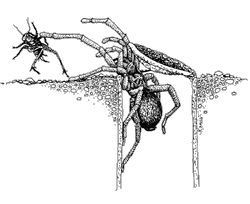Trapdoor Spider
Ummidia spp.
Family: Ctenizidae
Spanish name: ara�a terafosa
Description
Trapdoor spiders are close relatives of tarantulas, and their general appearance is similar, but they can be distinguished by their small size, less hairy abdomens, and legs that shine almost as if polished.
Distribution and Habitat
These spiders range from Virginia south to Florida and west to California. Trapdoor spider tubes are usually found in the sides of banks in disturbed areas.
Ecology
Trapdoor spiders prey on large terrestrial arthropods, and even occasionally on small lizards. They themselves are preyed on extensively in some areas by parasitic wasps of the family Pompilidae.
Perhaps the most interesting aspect of these spiders is their architecture. They build tube-like tunnels in the sides of banks in disturbed areas, along natural insect walkways. The tunnel is capped with an ingenious trapdoor. Trapdoor spiders are well-adapted for the strenuous activity of tunnel-building. Their chelicerae are equipped with digging rakes (rastella) that are used to loosen earth during the digging process, and then to roll it into a ball which is thrown from the developing burrow with strong, spined hind legs. Once the initial tunnel has been constructed, it is reinforced with a coating of a mixture of earth and saliva. Next a layer of silk is added, this being spun in one piece. The last step, the addition of the door, is the part of the process that differs from species to species. Two types of doors may be constructed. The most well-known is the �cork�-type door, which is very thick and beveled to fit the opening exactly. The other is the �wafer�-type door, which is a simply-constructed sheet of silk and dirt. The species also differ as to whether the tunnels are simple, or branching, with multiple doors. In all cases, however, the doors are equipped with silk hinges for easy opening and closing.
 |
The tunnel is used by the trapdoor spider as shelter from the elements and predators, as a nursery, and as a trapping device. The top of the door is usually camouflaged with bits of debris, such as twigs and rock, making its discovery very difficult. This results in fooling prey as well as predators, thereby making it a very effective shelter and trap. When the spider is using the trap to capture prey, its chelicerae hold the lid shut on the end of the door farthest from the hinge. It awaits the vibrations of passing prey conducted by the silk, quickly throws open the door, grabs the prey and returns with it down the tube. Although the lid stays shut easily on its own, attacks by predators can be discouraged by the spider holding the lid closed with its chelicerae, and, at the same time, bracing its legs against the wall of the tunnel. The only predators that are not dissuaded by this seem to be parasitic wasps, which simply chew right through the door.
The tunnel is also used by the female as a nursery. She lays her eggs in the tube and immediately covers them in a sac which is attached to the tunnel wall. She remains with them until hatching and beyond, allowing them to remain unharmed in the burrow until they are as much as eight months old.











